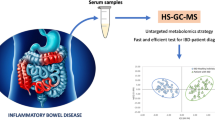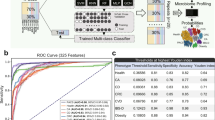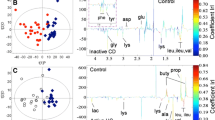Abstract
Gastrointestinal diseases such as irritable bowel syndrome, Crohn’s disease (CD) and ulcerative colitis are a growing concern in the developed world. Current techniques for diagnosis are often costly, time consuming, inefficient, of great discomfort to the patient, and offer poor sensitivities and specificities. This paper describes the development and evaluation of a new methodology for the non-invasive diagnosis of such diseases using a combination of gas chromatography mass spectrometry (GC–MS) and chemometrics. Several potential sample matrices were tested: blood, breath, faeces and urine. Faecal samples provided the only statistically significant results, providing discrimination between CD and healthy controls with an overall classification accuracy of 85 % (78 % specificity; 93 % sensitivity). Differentiating CD from other diseases proved more challenging, with overall classification accuracy dropping to 79 % (83 % specificity; 68 % sensitivity). This diagnostic performance compares well with the gold standard technique of colonoscopy, suggesting that GC–MS may have potential as a non-invasive screening tool.


Similar content being viewed by others
References
Abraham, C., & Cho, J. H. (2009). Inflammatory bowel disease. New England Journal of Medicine, 361(21), 2066–2078.
Angriman, I., Scarpa, M., et al. (2007). Enzymes in feces: Useful markers of chronic inflammatory bowel disease. Clinica Chimica Acta, 381(1), 63–68.
Barker, M., & Rayens, W. (2003). Partial least squares for discrimination. Journal of Chemometrics, 17(3), 166–173.
Brereton, R. G. (2003). Chemometrics: Data analysis for the laboratory and chemical plant. Chichester: Wiley.
Brereton, R. G. (2009). Chemometrics for pattern recognition. Chichester: Wiley.
Campbell, M. J., & Machin, D. (1999). Medical statistics: A common sense approach. Chichester: Wiley.
de Jong, S. (1993). SIMPLS: An alternative approach to partial least squares regression. Chemometrics and Intelligent Laboratory Systems, 18(3), 251–263.
Farrell, R. J., Banerjee, S., et al. (2001). Recent advances in inflammatory bowel disease. Critical Reviews in Clinical Laboratory Sciences, 38(1), 33–108.
Fefferman, D. S., & Farrell, R. J. (2005). Endoscopy in inflammatory bowel disease: Indications, surveillance and use in clinical practice. Clinical Gastroenterology and Hepatology, 3, 11–24.
Hagan, M. T., Demuth, H. B., et al. (1996). Neural network design. Boston: International Thompson Publishing.
Hotelling, H. (1931). The generalization of student’s ratio. Annals of Mathematics and Statistics, 2(3), 360–378.
Kussmann, M., Raymond, F., et al. (2006). OMICS-driven biomarker discovery in nutrition and health. Journal of Biotechnology, 124(4), 758–787.
Langhorst, J., Kühle, C. A., et al. (2007). MR colonography without bowel purgation for the assessment of inflammatory bowel diseases: Diagnostic accuracy and patient acceptance. Inflammatory Bowel Diseases, 13(8), 1001–1008.
Lavine, B., & Workman, J. J. (2004). Chemometrics. Analytical Chemistry, 76(12), 3365–3372.
Lechner, M., Colvin, H. P., et al. (2005). Headspace screening of fluid obtained from the gut during colonoscopy and breath analysis by proton transfer reaction–mass spectrometry: A novel approach in the diagnosis of gastro-intestinal diseases. International Journal of Mass Spectrometry, 243(2), 151–154.
Makidono, C., Mizuno, M., et al. (2004). Increased serum concentrations and surface expression on peripheral white blood cells of decay-accelerating factor (cd55) in patients with active ulcerative colitis. Journal of Laboratory and Clinical Medicine, 143(3), 152–158.
Manes, G., Imbesi, V., et al. (2009). Use of colonoscopy in the management of patients with Crohn’s disease: Appropriateness and diagnostic yield. Digestive and Liver Disease, 41(9), 653–658.
Mendoza, J. L., & Abreu, M. T. (2009). Biological markers in inflammatory bowel disease: Practical consideration for clinicians. Gastroentérologie Clinique et Biologique, 33(Supplement 3), S158–S173.
Moum, B., Ekbom, A., et al. (1997). Inflammatory bowel disease: Re-evaluation of the diagnosis in a prospective population based study in south eastern Norway. Gut, 40, 328–332.
Nakamura, R. M., & Barry, M. (2001). Serologic markers in inflammatory bowel disease (IBD). Medical Laboratory Observations, 33, 8–15.
Nakamura, R. M., Matsutani, M., et al. (2003). Advances in clinical laboratory tests for inflammatory bowel disease. Clinica Chimica Acta, 335(1–2), 9–20.
Otto, M. (1999). Chemometrics: statistics and computer applications in analytical chemistry. Germany: Wiley.
Papadakis, K. A., & Targen, S. A. (1999). Current theories of the causes of inflammatory bowel disease. Gastroenterology Clinics of North America, 28, 283–296.
Pasikanti, K. K., Esuvaranathan, K., et al. (2010). Noninvasive urinary metabonomic diagnosis of human bladder cancer. Journal of Proteome Research, 9(6), 2988–2995.
Pasikanti, K. K., Ho, P. C., et al. (2008). Gas chromatography/mass spectrometry in metabolic profiling of biological fluids. Journal of Chromatography B, 871(2), 202–211.
Peakman, T. C., & Elliott, P. (2008). The UK Biobank sample handling and storage validation studies. International Journal of Epidemiology, 37(suppl 1), i2–i6.
Rahman, Q., & Schmeisser, G. (1990). Characterization of the speed of convergence of the trapezoidal rule. Numerische Mathematik, 57(1), 123–138.
Sattlecker, M., Bessant, C., et al. (2010). Investigation of support vector machines and Raman spectroscopy for lymph node diagnostics. Analyst, 135(5), 895–901.
Schoepfer, A. M., Dehlavi, M.-A., et al. (2013). Diagnostic delay in Crohn’s disease is associated with a complicated disease course and increased operation rate. American Journal of Gastroenterology, 108(11), 1744–1753.
Seidman, E., & Deslandres, C. (1997). Pitfalls in the diagnosis and management of pediatric IBD. Lancaster: Kluwer Academic Publishing.
Stange, E. F., Travis, S. P. L., et al. (2008). European evidence-based consensus on the diagnosis and management of ulcerative colitis: Definitions and diagnosis. Journal of Crohn’s and Colitis, 2(1), 1–23.
Tomasi, G., van den Berg, F., et al. (2004). Correlation optimized warping and dynamic time warping as preprocessing methods for chromatographic data. Journal of Chemometrics, 18(5), 231–241.
van den Berg, R., Hoefsloot, H., et al. (2006). Centering, scaling, and transformations: Improving the biological information content of metabolomics data. BMC Genomics, 7(1), 142.
Vella, M., Masood, M. R., et al. (2007). Surgery for ulcerative colitis. The Surgeon, 5(5), 355–362.
von Stein, P., Kouznetsov, N., et al. (2007). P032 multi-gene approach to discriminate for ulcerative colitis, Crohn’s disease and irritable bowel syndrome. Journal of Crohn’s and Colitis Supplements, 1(1), 12.
von Stein, P., Lofberg, R., et al. (2008). Multigene analysis can discriminate between ulcerative colitis, Crohn’s disease, and irritable bowel syndrome. Gastroenterology, 134(7), 1869–1881.
Walton, C., Fowler, D. P., et al. (2013). Analysis of volatile organic compounds of bacterial origin in chronic gastrointestinal diseases. Inflammatory Bowel Diseases, 19(10), 2069–2078.
Westerhuis, J., Hoefsloot, H., et al. (2008). Assessment of PLSDA cross validation. Metabolomics, 4(1), 81–89.
Wiklund, S., Johansson, E., et al. (2007). Visualization of GC/TOF-MS-based metabolomics data for identification of biochemically interesting compounds using OPLS class models. Analytical Chemistry, 80(1), 115–122.
Wold, S., Esbensen, K., et al. (1987). Principal component analysis. Chemometrics and Intelligent Laboratory Systems, 2(1–3), 37–52.
Zweig, M. H., & Campbell, G. (1993). Receiver-operating characteristic (ROC) plots: A fundamental evaluation tool in clinical medicine. Clinical Chemistry, 39(4), 561–577.
Acknowledgements
We gratefully acknowledge the Wellcome Trust for funding the work (Project 080238/Z/06/Z).
Author information
Authors and Affiliations
Corresponding author
Electronic supplementary material
Below is the link to the electronic supplementary material.
Rights and permissions
About this article
Cite this article
Cauchi, M., Fowler, D.P., Walton, C. et al. Application of gas chromatography mass spectrometry (GC–MS) in conjunction with multivariate classification for the diagnosis of gastrointestinal diseases. Metabolomics 10, 1113–1120 (2014). https://doi.org/10.1007/s11306-014-0650-1
Received:
Accepted:
Published:
Issue Date:
DOI: https://doi.org/10.1007/s11306-014-0650-1




